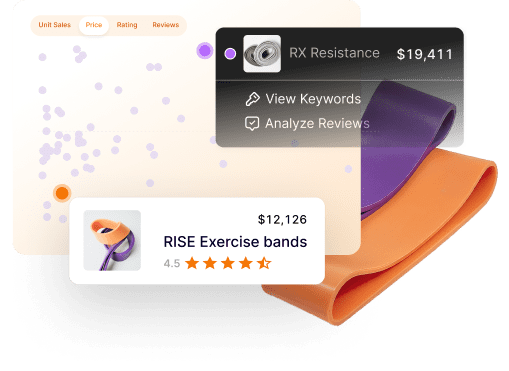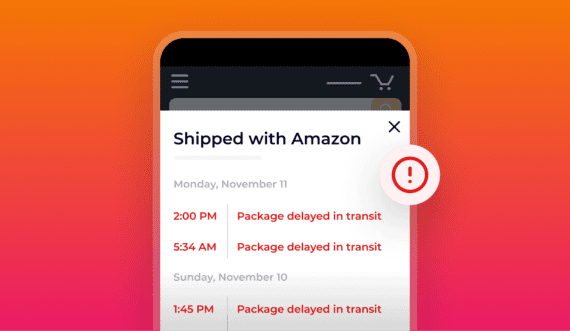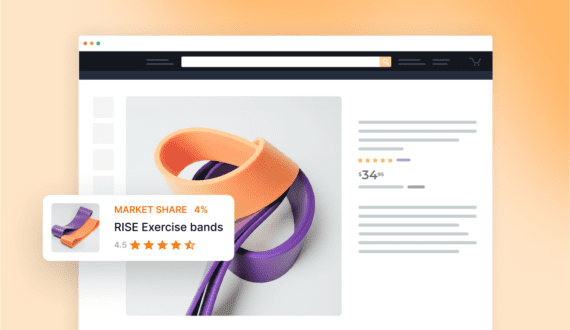Amazon is a search engine as much as a marketplace, and understanding Amazon SEO (search engine optimization) is essential for sellers looking to boost their product visibility and sales. To stay competitive, it’s crucial to rank higher on Amazon’s search results.
Optimizing product listings with Amazon SEO principles can boost keyword search rankings, improve conversion rates, and ultimately drive sales.
This guide explores key strategies, best practices, and advanced SEO tactics experienced sellers can use to optimize product listings for maximum visibility on Amazon.
What is Amazon SEO and why is it important?
Amazon SEO is the process of optimizing product listings with relevant, high-volume keywords to appear higher in Amazon’s search results.
Since Amazon customers usually don’t browse past the first few pages of search results, a high-ranking listing can significantly improve your product’s visibility and sales. The more your listing converts, the higher your listings will rank for a specific keyword.
Amazon SEO considers several factors, such as keyword relevancy, sales velocity, and conversion rate, which help Amazon’s search engine (known as the A9 algorithm) decide which listings are most relevant to a customer’s search query.
Effective Amazon SEO ensures your products are easily discoverable, giving you a competitive edge in the crowded ecommerce marketplace.
Improving the SEO of your listings is very important because 52% of consumers search their online product search on Amazon.

So, if you understand proper Amazon SEO strategy, then your products’ visibility and Amazon ranking improve, which drives more sales!
A9: The foundation of Amazon SEO
The Amazon A9 algorithm determines the ranking of product listings by evaluating factors like keyword relevancy, sales velocity, and customer satisfaction.
Unlike Google, which focuses on information retrieval, Amazon’s A9 is tailored for commercial intent, prioritizing listings most likely to convert into a sale. Understanding the nuances of A9 can guide sellers in optimizing their listings to satisfy both the algorithm and customer needs. With each algorithm update, Amazon continues to prioritize a mix of relevancy and performance metrics, keeping conversion-focused listings at the top of search results.
This algorithm is crucial to Amazon’s business model because it powers the primary metric that matters the most: revenue per click. And by honing in on the products most relevant to a customer’s search query, Amazon increases its chances of generating a sale — and revenue.
We get a sense of what the A9 algorithm targets in Amazon’s help page on Optimize your product discoverability:
“Factors such as degree of text match, price, availability, selection, and sales history help determine where your product appears in a customer’s search results. By providing relevant and complete information for your product, you can increase your product’s visibility and sales.”
What makes a product rank on Amazon?
While Amazon keeps a tight lid on the details of its A9 Search Algorithm, there are a few key factors that we know help to determine a product’s rank.
For example, when you create an Amazon product listing, you are telling Amazon: “Hey, this is what my product is.”
Then, when customers click on your product listing and make a purchase, they, too, are telling Amazon: “Yes, this product is exactly as described and is what I was looking for.”
Think of Amazon’s A9 search engine as the smartest person you’ve ever met. However, this person lacks confidence in their answers. It’s not until a few thousand people tell the person they’re right that they start to believe it themselves.
And that’s Amazon SEO and the A9 algorithm in a nutshell.
Keyword research
Keywords are essential to Amazon SEO. By targeting relevant keywords, sellers can align their listings with customers’ searches.
Effective keyword research tools help identify phrases with high search volume that accurately describe the product.
Jungle Scout’s Keyword Scout tool can simplify this process by helping sellers find high-ranking keywords, assess search volume, and identify long-tail keywords for increased visibility.
When you create your Amazon FBA product listing, Amazon requires a lot of information including:
- The product’s title
- The product’s images
- Bullet points offering a quick description of the product
- A longer description of the product
- Back-end keywords and categories
All of these listing elements must be filled with relevant keywords, as Amazon’s algorithm uses them to understand your product.
Sales velocity
Sales velocity, or the rate at which a product sells, is a significant factor in Amazon’s ranking algorithm.
The more a product sells, the higher it ranks, creating a positive feedback loop. To increase sales velocity, sellers can use tactics such as running promotions, offering competitive pricing, and leveraging Amazon PPC ads to drive traffic to their listings.
Here’s an example to help clarify how sales velocity is calculated:
In one month, your product page has 3,000 opportunities to make a sale, also known as page impressions (ie. the number of people visiting your product listing).
The product price is $20.
Your conversion rate is 10% (conversion rate = total order items sessions).
The sales cycle is 30 days.
(3000 x 20) 0.10 / 30 = 200
That means your sales velocity is $200 per day.
Conversion rate
Conversion rate is the percentage of visits to your product page that results in a sale. It is calculated as follows:
Conversion rate = Total order items / Sessions
Amazon favors products with higher conversion rates, as this signals relevance and customer satisfaction.
Higher conversion rates can be achieved by refining product images, writing clear and persuasive copy, gathering positive reviews, and ensuring competitive pricing.
A higher conversion rate can significantly improve a product’s ranking, increasing visibility and sales.
In Seller Central, you can see the conversion rate of your product by going to Reports –> Business Reports –> Detail Page Sales and Traffic and then looking at the Unit Session Percentages.

Amazon SEO: Product listing best practices
As we’ve discussed, the primary ingredient to rank your product highly within Amazon’s search results pages is SEO relevancy, and every element on an Amazon product listing helps with relevancy.
Understanding the structure of an Amazon product listing
An Amazon product listing hasseveral elements, including the title, bullet points, product description (or A+ Content), and backend keywords. Structuring each of these elements with SEO best practices in mind can improve both rankings and conversions.
Before we go into the individual components of your Amazon product listing, you must understand the actual structure of the listing itself.
Amazon’s user experience designers placed each element of a product listing in a specific position, based on common internet-user reading habits (most internet users — you and I included — read in an F-shapedpattern).

First, the user starts at the top-left corner of the screen, scanning the content. On Amazon search results pages and product listings, the first things the user sees are the product photos.
Next, it’s the product’s title (with the price very close to the top). And at the far right of the listing, still in line with the other content, is the Buy Box.
If the user does not make an immediate purchase based on the image, title, and price, they scroll further down the page and make a second horizontal movement. That means the user sees the items’ delivery options, product variants, and bullet points.
The final movement involves the pattern’s vertical movement.
As a user scrolls past ‘the fold’ on an Amazon page (the portion of the page a user sees when they first visit a product page), they are treated to more content to convince them to make a sale. This includes competitor products, offers and promotions, a detailed product description, questions and answers, and reviews.
The most important elements of an Amazon product listing
With this knowledge of a user’s reading pattern, we can order the product listing’s elements from most important to least important.
Above the fold:
When it comes to the components of a product listing, those that are ‘above the fold’ can be seen by a potential buyer when they first click through to your page, without scrolling down.
They include:
- Product images. Amazon is very much a visual website. Therefore, product photos are the first thing a customer sees when their search results come up, helping to confirm that their search terms are correct.
- Product title. Next, the product title makes its debut in the reader’s field of vision. The title supplies a lot of important information, for further confirmation that the product was relevant to the customer’s search.
- Amazon badges. There are severalbadges that can be associated with a product listing. If a product leads in its parent category, for example, Amazon awards it a ‘Best Seller’ or ‘Amazon’s Choice’ badge. Below the product’s rating is a badge that lets shoppers know the product qualifies for Prime.
- Product rating. Just below the product’s title is the product’s overall rating, and the number of ratings.
- The Buy Box: The Buy Box is the page’s call-to-action above the fold. It allows the buyer to immediately purchase the product from the product’s top seller.
- Variants. If the product has variants, these will appear below the product’s title and pricing information.
- Bullet points. Any details that the listing creator could not convey through the product’s images or title are placed in the bullet points. These details are less for establishing relevance, and more for helping customers make informed buying decisions.
Below the fold:
As for components ‘below the fold’, those are the listing’s elements that a shopper can only view if they scroll down the product page.
These include:
- “Customers who bought this item also bought…” This section is Amazon’s first line of defense against losing a potential conversion. Once a customer scrolls past the fold without clicking the Buy Box, Amazon ensures that other options are put in front of the potential buyer.
- “Sponsored products related to this item…” Like the section above, sponsored products work towards ensuring a sale is made.
- Special offers and product promotions. Next, the product listing might offer promotions to convert shoppers who couldn’t be persuaded to buy above the fold or to click on one of the other product listings.
- Product description (or A+ Content). The description is the closer of an Amazon product listing. If the image, title, price, and other above-the-fold features fail to get the job done, it’s up to the description to convince the shopper to buy.
- Reviews. Finally, the product’s ratings are accompanied by its reviews. The reviews either change the buyer’s mind and turn them into a shopper, or they act as confirmation bias for shoppers on the fence about buying.
How to improve SEO on Amazon: The do’s and don’ts
Now that you’re armed with a basic understanding of Amazon SEO and user experience, you should be able to optimize your Amazon product listing for relevancy and conversions (sales velocity).
What you can do to improve your listing
- Choose relevant, high-quality product images: Images are essential to convey product value and establish trust. Use high-quality images that accurately represent the product.
- Optimize product descriptions and titles: Write a title that includes primary keywords and describes the product succinctly. In the description, use persuasive language and address potential customer concerns. Use Jungle Scout’s Listing Builder with AI Assist to help you write an optimized product listing.
- Gather positive ratings and product reviews: Customer feedback signals product quality to both Amazon’s algorithm and future buyers. Encourage reviews to improve ranking and conversion rates by using Jungle Scout’s Review Automation tool.
- Price competitively: Customers prioritize value, so competitive pricing is key. Consider offering promotions or fulfilling your orders with FBA to enable Amazon Prime shipping to appeal to more buyers.
- Track your Amazon listings with Jungle Scout: Use Jungle Scout’s Rank Tracker to monitor your listings’ keyword performance and track competitors, allowing you to make data-informed decisions.
- Keep control of the Buy Box: Winning the Buy Box is essential for sales. Ensure product availability, competitive pricing, and high ratings to maintain control.
- Offer variants whenever possible: Multiple product options can attract a broader audience and increase conversion rates.
- Write conversion-focused bullet points: Bullet points should be informative, keyword-optimized, and highlight product benefits without any fluff.
- Study your competitors’ listings: Analyzing competitor listings using Jungle Scout’s Competitive Intelligence can provide insights into keyword usage, pricing strategies, and other tactics that can improve your listing.
- Run Amazon PPC (Pay-Per-Click) ads: Amazon advertising can boost visibility, driving more traffic to listings and potentially improving ranking.
What you should avoid to improve your Amazon SEO:
- Don’t overuse keywords: Avoid keyword stuffing, as it can harm readability and result in lower conversion rates.
- Don’t ignore backend keywords: Make full use of backend keywords to increase your product’s visibility.
- Don’t use unverified Claims: Exaggerated claims can lead to customer dissatisfaction and negative reviews.
- Don’t neglect competitive analysis: Regularly reviewing competitor listings can highlight opportunities for improvement.
- Don’t forget to monitor metrics: Tracking performance metrics using Jungle Scout’s suite of tools allows you to make adjustments and maintain ranking.
Rank higher and sell more with Jungle Scout’s SEO-friendly tools
Optimizing for Amazon SEO is an ongoing process that drives visibility, traffic, and sales.
Jungle Scout’s suite of SEO-friendly tools can streamline and enhance your listing optimization efforts, offering keyword research, sales and keyword tracking, and competitor analysis.
By using Jungle Scout’s tools, Amazon sellers can stay ahead in the Amazon marketplace and ensure their products remain competitive. Jungle Scout is an essential tool for all sellers looking to take their Amazon SEO to the next level.
Learn more about how you can use Jungle Scout to improve your Amazon SEO.
Brian Connolly is an Amazon seller, ecommerce expert, and writer for Jungle Scout. He lives in the New Jersey Shore area with his wife and cat. When he isn’t writing advice online for aspiring and experienced Amazon sellers for Jungle Scout, he spends his free time boating, fishing, and selling boating-themed items on his Amazon business.










